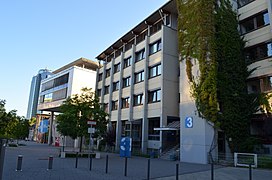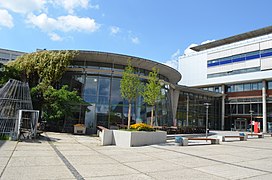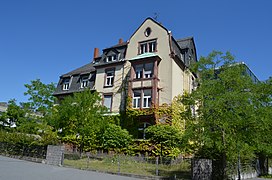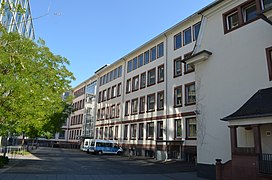
Darmstadt is a city in the state of Hesse in Germany, located in the southern part of the Rhine-Main-Area. Darmstadt has around 160,000 inhabitants, making it the fourth largest city in the state of Hesse after Frankfurt am Main, Wiesbaden, and Kassel.
TU Dresden, also as the Dresden University of Technology, is a public research university in Dresden, Germany. It is the largest institute of higher education in the city of Dresden, the largest university in Saxony and one of the 10 largest universities in Germany with 32,389 students as of 2018.

The Berlin-Brandenburg capital region is one of the most prolific centers of higher education and research in the world. It is the largest concentration of universities and colleges in Germany. The city has four public research universities and 27 private, professional and technical colleges (Hochschulen), offering a wide range of disciplines. Access to the German university system is tuition free.

Technical University of Kaiserslautern was a public research university in Kaiserslautern, Germany.

The Hamburg University of Applied Sciences is a higher education and applied research institution located in Hamburg, Germany. Formerly known as Fachhochschule Hamburg, the Hamburg University of Applied Sciences was founded in 1970. In terms of student enrolment, the HAW is the second-largest university in Hamburg and the fourth-largest applied sciences university in Germany, with a student body of 16.454.

The FOM University of Applied Sciences for Economics and Management is Germany's largest private university. The business school is privately run, works in close co-operation with other universities, and is state recognized. With more than 42,000 students the FOM is the largest private university in Germany. Also it has the biggest economic and business sciences faculty in Germany.

The Leipzig University of Applied Sciences, in German the Hochschule für Technik, Wirtschaft und Kultur (HTWK), is a Fachhochschule in Leipzig, in the Saxony region of Germany. It offers a combination of practice-oriented teaching and application-driven research, with a particularly broad spectrum of engineering and technical disciplines, as well as in the fields of economics, social science and culture. It offers more than 40 degree courses. There are currently about 6,200 students enrolled at HTWK. Leipzig.
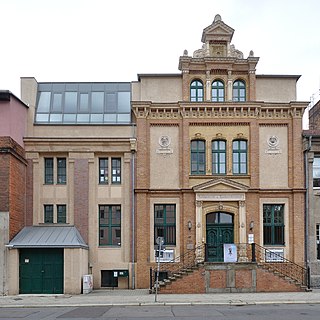
A Kunstgewerbeschule was a type of vocational arts school that existed in German-speaking countries from the mid-19th century. The term Werkkunstschule was also used for these schools. From the 1920s and after World War II, most of them either merged into universities or closed, although some continued until the 1970s.
The Zürich University of Applied Sciences is a governing body composed of four separate universities. It is located in the city of Winterthur, with facilities in Zürich and Wädenswil, is the second largest university in Switzerland after the University of Zurich.
The Mainz University of Applied Sciences, is a 1971-founded university located in Mainz, in the western German state of Rhineland-Palatinate. The University of Applied Sciences Mainz consists of three faculties: School of Technology, School of Design and School of Business. The common feature of all fields of study is the practical orientation of the university, the short periods of study and the internationally orientated courses.
The Zurich University of Applied Sciences located in the city of Winterthur, with facilities in Zurich and Wädenswil, is one of the largest University of Applied Sciences in Switzerland and is part of the Zürcher Fachhochschule.

The RheinMain University of Applied Sciences, formerly University of Applied Sciences Wiesbaden, is a university located in Wiesbaden, Germany, founded in 1971. It is part of the IT-Cluster Rhine-Main-Neckar, the "Silicon Valley of Europe".
Koblenz University of Applied Sciences is a public university in Rhineland-Palatinate. Although the present university was established in 1996, it has a rich tradition in higher education. The roots of today's Faculty of Materials Engineering, Glass and Ceramics in Hoehr‑Grenzhausen, come down to the 19th century.
The Berliner Hochschule für Technik (BHT) is the second largest University of Applied Sciences in Berlin, Germany. There are around 12 000 students studying at BHT in more than 70 majors and 795 employees, under which there are 291 professors and 43 guest lecturers.

The Hochschule Hannover - University of Applied Sciences and Arts (HsH) is a public Fachhochschule in Hanover. It's the second largest university in Hanover with approximately 10,000 enrolled students in the winter term 2021/2022 and 620 professors and employees. In addition there are around 430 guestlecturers from other academic institutes, organisations and companies teaching at the HsH. The Hochschule Hannover has four locations.
The Regensburg University of Applied Sciences is a university of applied sciences (UAS) in Regensburg, Germany. It was founded in 1971 as a college for technology, economics and social work, but has roots in the mid-19th century. Today, the university is one of the largest universities of applied sciences in Bavaria. As of the 2023/2024 winter semester, its eight faculties offer 33 Bachelor's degree programs, 20 Master's degree programs, four part-time Bachelor's degree programs, and four continuing education Master's degree programs. The focus is on engineering and computer sciences as well as law, economics and social sciences.

The Technical University of Applied Sciences Würzburg-Schweinfurt is a technical university in Germany, which was founded originally in 1807, and was restructured during 1971. The university is among the applied sciences universities in Germany with over 150 partner universities worldwide. The university is located in Bavaria with campuses in Würzburg and Schweinfurt.
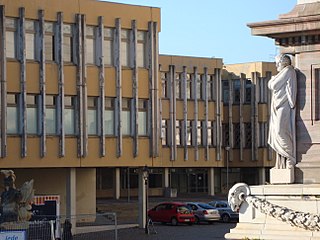
The Fachhochschule Potsdam is a University of Applied Sciences in Potsdam, the capital of the German federal state of Brandenburg. It was founded in 1991 and teaching began in the 1991/92 winter semester.
Osnabrück University of Applied Sciences is a university of applied science in Lower Saxony, whose administrative centre is in Osnabrück. It has existed in its current form since 2003, having originally opened in 1971. Some of its departments can be traced back to engineering schools and other colleges operating as early as the 1950s.





